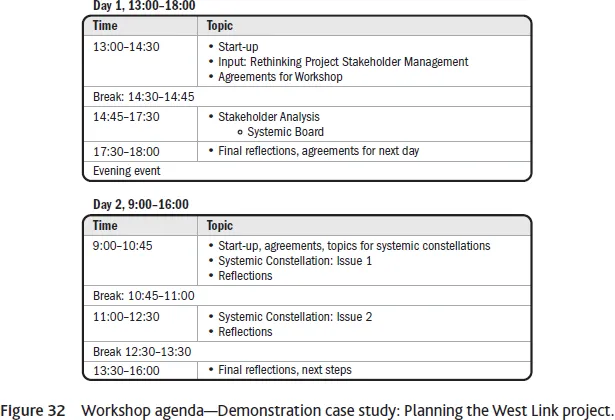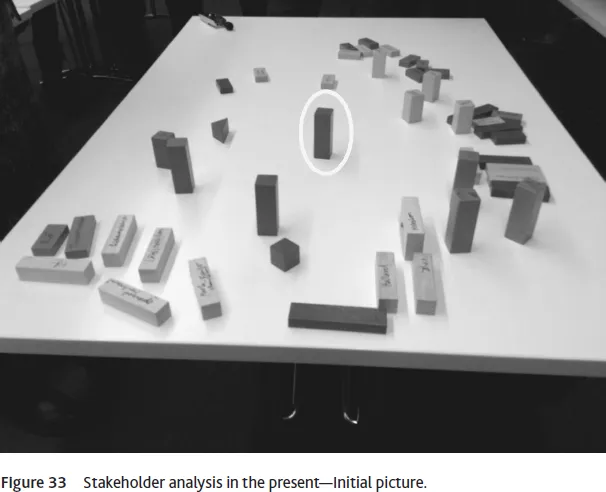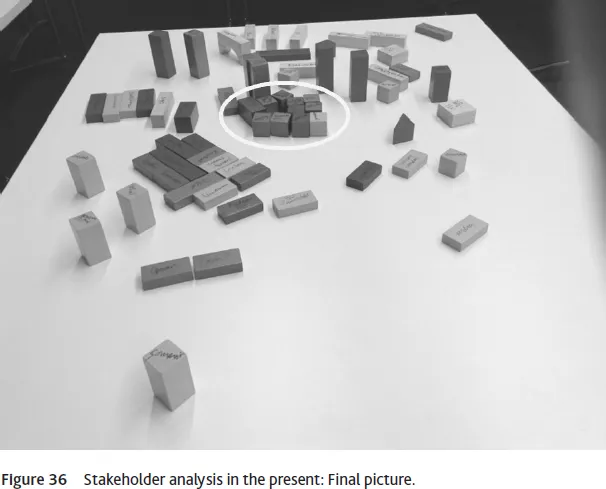
This is a test
- 213 pages
- English
- ePUB (mobile friendly)
- Available on iOS & Android
eBook - ePub
Rethink! Project Stakeholder Management
Book details
Book preview
Table of contents
Citations
About This Book
Rethink! Project Stakeholder Management broadens the current view of project landscapes in this thoroughly researched investigation of project stakeholder theory, methods, and practices. Building on the current literature, Huemann, Eskerod, and Ringhofer portray the two most common stakeholder management approaches as existing on a continuum between managing of stakeholders and managing for stakeholders. Their research study offers detailed insights into how four contemporary projects, each with complex stakeholder situations and different stakeholder management styles, used focus groups and systemic constellation methods to aid project teams in clarifying roles, visualizing relationships, and identifying stakeholders and their needs.
Frequently asked questions
At the moment all of our mobile-responsive ePub books are available to download via the app. Most of our PDFs are also available to download and we're working on making the final remaining ones downloadable now. Learn more here.
Both plans give you full access to the library and all of Perlego’s features. The only differences are the price and subscription period: With the annual plan you’ll save around 30% compared to 12 months on the monthly plan.
We are an online textbook subscription service, where you can get access to an entire online library for less than the price of a single book per month. With over 1 million books across 1000+ topics, we’ve got you covered! Learn more here.
Look out for the read-aloud symbol on your next book to see if you can listen to it. The read-aloud tool reads text aloud for you, highlighting the text as it is being read. You can pause it, speed it up and slow it down. Learn more here.
Yes, you can access Rethink! Project Stakeholder Management by Pernille Eskerod, PhD, MSc, Martina Huemann in PDF and/or ePUB format, as well as other popular books in Business & Project Management. We have over one million books available in our catalogue for you to explore.
Information
CHAPTER | 9 |
Demonstration Case Study for the Planning the West Link Project
9.1 Introduction
In the following chapter, we describe the demonstration case study of the systemic constellations we performed for stakeholder issues of the Planning the West Link project. We applied a systemic board constellation and two management constellations with the project team. For a more comprehensive description of the Planning the West Link project, refer to Chapter 5.
In the following discussion, we first clarify the workshop setting and the types of systemic constellations we applied in this demonstration case study. We describe the application of the systemic board constellation for project stakeholder analysis. Then, we show the process and some exemplary details of the insights and results of the two management constellations conducted. Finally, we compare the constellation methods, evaluate them, and reflect on them.
9.2 Types of Constellations, Purpose, and Workshop Setting
Workshop and Types of Constellations
We conducted a 1.5 day workshop on the site of the project team. The project team members and other members of the project organization of the Planning the West Link project attended the workshop. The workshop took place in January 2014. We applied a systemic board constellation and two management constellations. In Figure 32, we provide the workshop agenda.
The room where the workshop took place had a window in front on the right side. Looking out of the window, an area that was going to be rebuilt during the project could be seen. On the other side of the room, there was a glass wall that provided a view into the offices of the project team members.

Objectives and Roles
The objectives of the workshop were to conduct the demonstration case study. The objectives were twofold. On the one hand, the researchers wanted to experiment with different types of constellations for stakeholder analysis in a setting that engages a project team. On the other hand, the project manager and the project team were interested in generating insights for their stakeholder management.
Project representatives (including the project director, project team members, and further project contributors), researchers, and a constellation expert participated in the workshop. The research team participated with one of the principal researchers, two research assistants, and Daniela Andratsch, an experienced systemic constellation expert, who facilitated the management systemic constellations.
9.3 Systemic Board Constellation for Stakeholder Analysis
Objectives, Setting, Roles, and Process
The aim for applying the systemic board was to perform a project stakeholder analysis, picture the complexity of the stakeholder landscape, discuss dynamics, and identify issues for further investigation in the management constellations planned. The project team wanted to generate a shared understanding on the current situation and future developments. Additionally, they were interested in considering sustainable development principles in the project stakeholder analysis. Thus, the facilitator offered to look into future projects in the chain of the Planning the West Link project.
The project team and some further representatives of the project organization engaged in the setting. For the systemic board constellation, a group setting was applied. The project team took ownership of the constellation. We distinguished several roles in this constellation setting. These were the constellation owner, constellation facilitator, and observers:
- Constellation owner: The project team, including the project director of the Planning the West Link project acted as constellation owner.
- Constellation facilitator: One of the principal researchers, who is trained and experienced in systemic board constellations, was the facilitator in this constellation.
- Observers: Two research assistants, a constellation expert, and further members of the Planning the West Link project observed the constellation. The research assistants documented the constellation process and findings.
All project team members and the project director, one after the other, took the lead in putting the colored wooden blocks on the table, which served as the constellation board. Each single block, in a different size and color, represented a different element/stakeholder. The style was individualized and cooperative, and engaged many discussions. It allowed the project team to generate a shared understanding of the project stakeholders and their relations.
The Planning the West Link project is a part of a chain of projects with quite a long duration (first trains are planned to run in 2026). It was, therefore, a challenge to make agreements with the project team that considered the same time-horizon for analyzing stakeholder relations.
“I think the most important stakeholders are almost the same during the different phases. We have some key stakeholders that you need to build a long-term relationship [with].” (Project team member)
The facilitator synchronized the project team regarding the time-horizon in which the stakeholders were analyzed. They started with the present, thus, with the planning of the West Link. Two more time phases would follow: the near future and the future. The future represented the construction phase. The near future represented the phase that started in 2015, in which the project needs to wait for permissions and prepare for the construction.
Following, the systemic constellation for a stakeholder analysis of the present (planning for the project), the near future (preparation), and the future (in which the construction will take place), is presented.
Stakeholder Analysis in the Present
The project's purpose was the planning of the West Link. That means the stakeholder analysis in the here and now was conducted. The facilitator asked the communication manager and her assistant to start with the constellation. They were asked to make the project stakeholders and their relations to the project in the present phase visible by using the wooden blocks and explaining what they were doing. The other project team members and workshop participants were observing the situation and listening.
Figure 33 shows the result of this initial constellation by the communication manager and her assistant. The tall red block in the middle was the Planning the West Link project.
This is the project, not the project team.


The communication manager mentioned that they now need to start concentrating on the public. To put the plan together, they needed to determine how to communicate with them.
We then invited other team members to express their views, ideas, and feelings about the picture shown on the systemic board by adding or changing positions or sharing their observations orally. The internal stakeholders were the different project departments that are involved in the project (see Figure 34). They were moved closer to the project.
In the discussion process, a conversation about the project owners came up. The project had two project owners with different interests. The project owners differed in both time and in the business case. The end goal was the same, but the outcomes were different. It was easier for the project team to meet the goals of the direct supervisor of the project director because these goals were clearer. These goals especially referred to the budget, the economy, and the technical details. The other project owner's interests were less clear.
The facilitator asked the individual team members how they felt about the positions of the project departments that they represented. They started to think about their actual position and a possible position in the project organization. The tower represented the project. One team member said:
“I am in the shadow of the tower, but I should be in the center.”
Finally, the project director removed the tower (red tall block), which represented the project. He referred to the project departments represented in the constellation and explained:
“I would like to remove the project, because I believe this is the project. We don't need this one. It is too static; the project is a dynamic thing. The politicians are switching positions depending on the question. And that's for everything.”
Comparing Figure 33 (the initial picture that was produced by the two communication managers) with Figure 35 (on which further team members had worked), clearly shows the dynamics and the change of the picture. It seems that the project was shrinking because the stakeholders were getting closer and closer.
One important stakeholder discussed by the project team was the media. It became clear that the media played an important role in the project stakeholder landscape, but was hard to control. The project director mentioned the importance of the media:


“I would like to have the control.”
The communication manager pointed out:
“They have a lot of influence on us, but we don't have it on them.”
Figure 36 shows the final constellation at the end of this first phase. The project, as an abstract element, was no longer part of the constellation. Instead, the project organizations represented by the different project departments were considered as representing the project. The constellation provided a picture of the stakeholders and their relations in the present.
Near Future: The Nonphase
The facilitator asked the project team which time-horizon they wanted to continue with for the stakeholder analysis. The team jumped right to the construction and started with rebuilding the constellation. The facilitator asked them why they have chosen the construction phase and not the phase that would come in the near future. After some hesitation, the team agreed that there was a phase of major uncertainty coming. One of the team members phrased this in-between phase, the “nonphase.”
Because there was a big question mark about this nonphase depending on the permissions, the project members did not want to speak about this phase. One team member mentioned:
“We don't really like uncertainties.”
Trying not to deal with uncertainty, the project team wanted to skip over this nonphase in the first place and think about the construction phase. However, the project team realized that they needed to deal, in some way, with this nonphase. The procurement manager mentioned:
“With the contract in the in-between phase, we have to start now with the contracts, so that they know exactly what is coming in the future, so we understand what it needs.”
The explanation was that a referendum would take place. Furthermore, an election was coming up. There was a lot of noise in the public because of extra taxes, which led to the upcoming referendum. The project “had” the money from the government, but they needed the permission from the government, and until they had the permission, a gap existed. This phase and the work with the stakeholders needed in this nonphase was a prerequisite for the future construction.
A team member said:
“The thing happening during thi...
Table of contents
- Cover Page
- Title Page
- Copyright Page
- Table of Contents
- List of Figures
- List of Tables
- Executive Summary
- Introduction
- Research Approach
- Stakeholder Theory and Stakeholder Management
- Systemic Constellation Methods
- Description of Case Study Projects
- Stakeholder Management Practices
- Demonstration Case Study for the Branding Slagelse Strategy Project
- Demonstration Case Study for the IT System Implementation Project
- Demonstration Case Study for the Planning the West Link Project
- Toward a Stakeholder-Oriented Project Management Approach
- Summary and Outlook
- Appendix A: Project Management Documents
- Appendix B: Overview of Publications and Presentations
- Appendix C: Interdisciplinary Research Workshops
- References